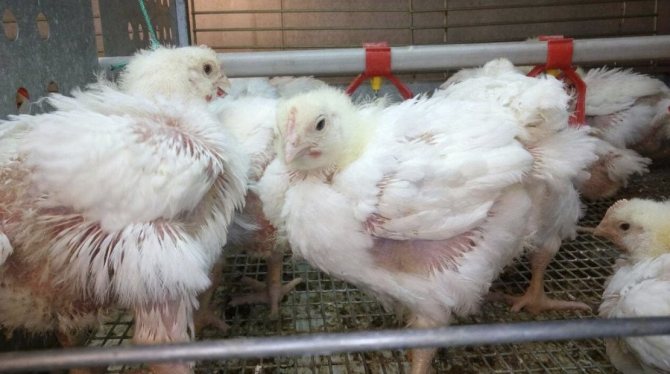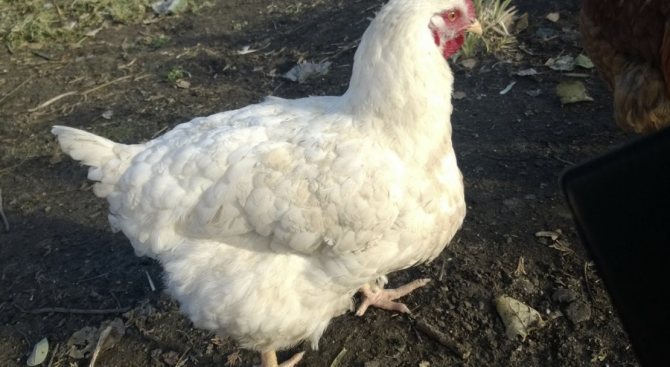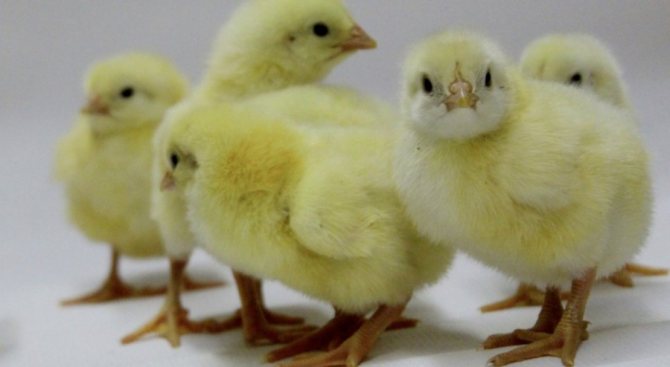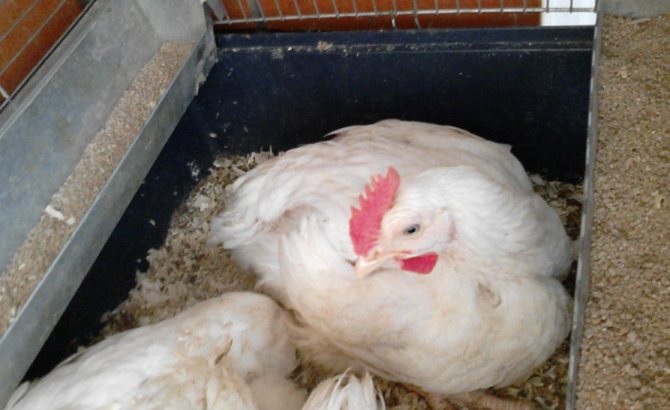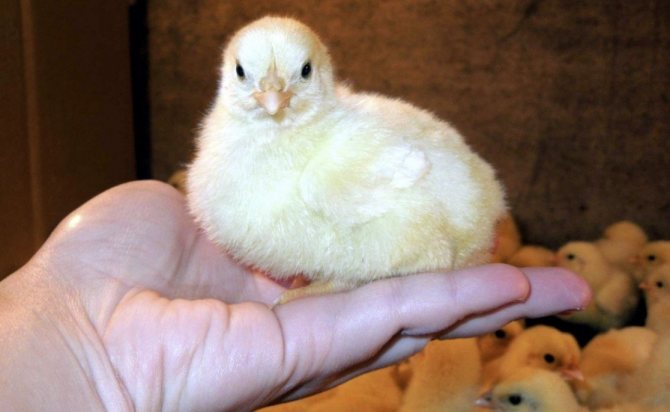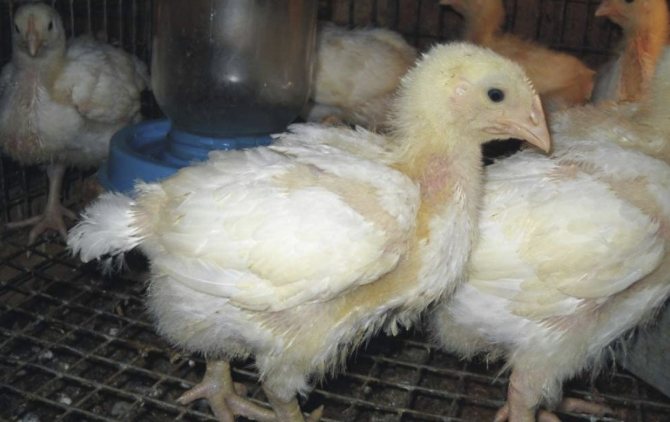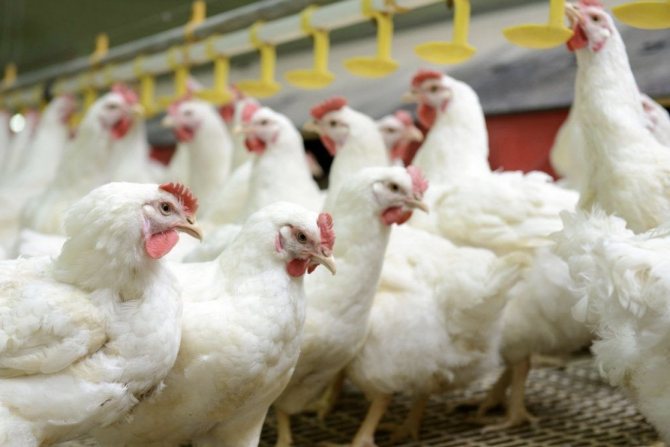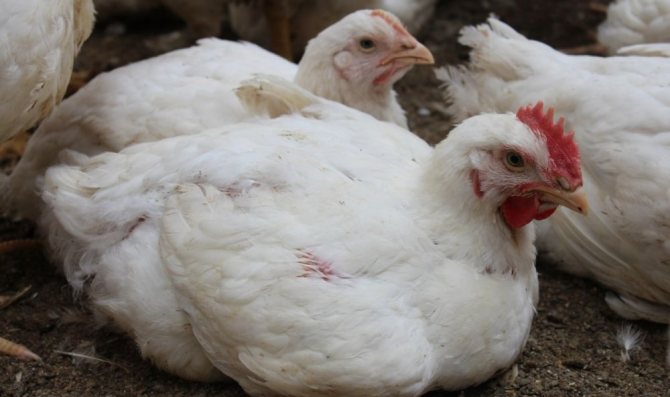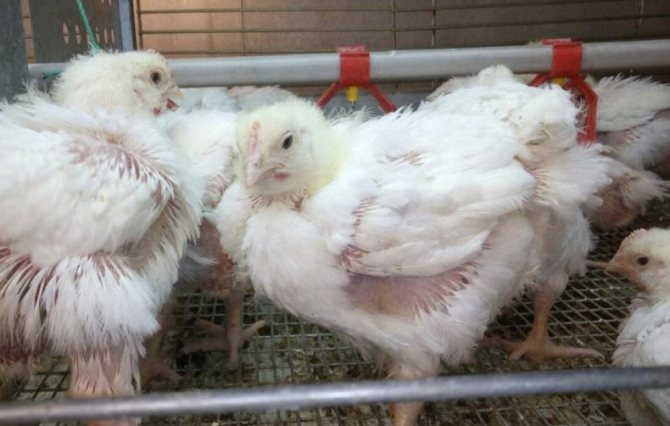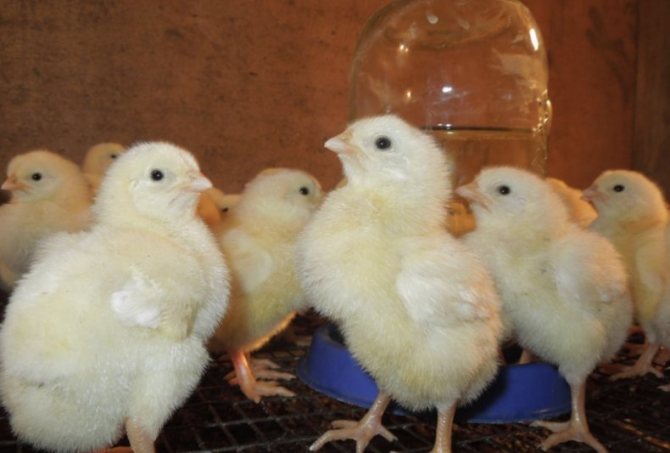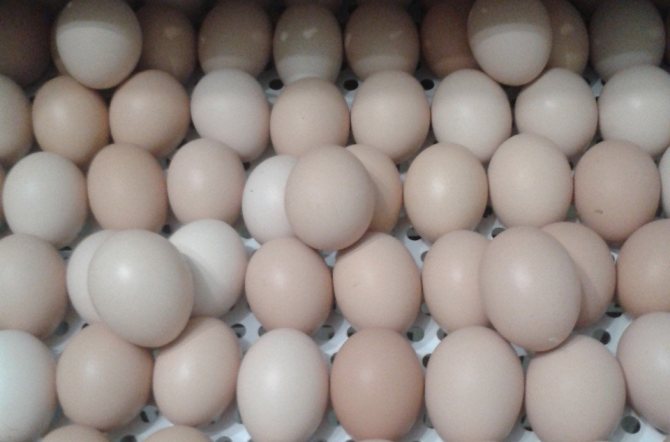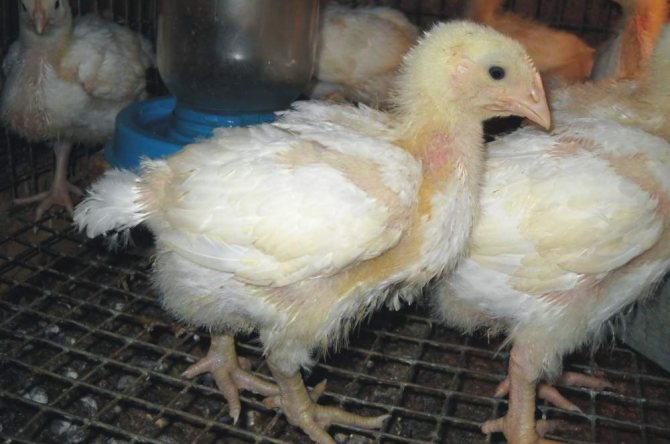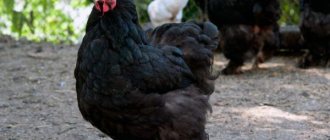
Homesteads supply 30% of the poultry and eggs produced throughout the country. A part goes to the needs of the owners, and the rest is sold through the sale on the market. Today, the highly productive breed of broiler Cobb 500 is very popular among poultry farmers, the cultivation of which at home is quite simple and economically profitable. A feature of this species is the rapid weight gain and unpretentious maintenance.
For those who previously kept broilers, the transition to raising chickens will not be something new, because the care technique is practically no different from the usual one. At the same time, the carcass has a pleasant yellow color, which makes the sold product unique and attractive.
But the sale of the resulting meat and eggs is the final stage. First, you need to grow a good quality bird, which will help this article. Here everyone will find a detailed description of the Cobb 500 chicken breed and the nuances of caring for them.
Productive qualities
Check out these articles as well
- How melon is useful for women and men
- Summer varieties of apple trees
- Chinese silk chicken - characteristics of the breed
- How to feed spring garlic
The productive qualities of the breed are the reason why breeders value or dislike it. What is the productivity of the Cobb 500?
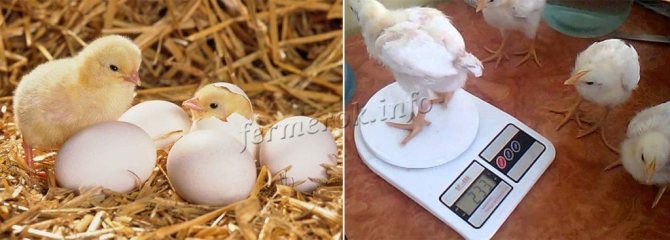

Photo of chicks broiler cobb 500
- The bird is early maturing, in 1.5-2 months after hatching from the egg, slaughter is carried out, but it is possible even earlier. So a month the birds weigh 2 kg, in a month and a half - 2.5-2.6 kg, and at 2 months they weigh 3 kg. It is unprofitable to keep the bird longer, after 2 months it practically does not grow, but it can eat at the same pace. But if there is a desire to wait up to 3-4 months, then you can get a bird within 5-6 kg.
Important!
The Cobb 500 is uniform. If the young hatched on the same day or with a small difference, by the time of slaughter the birds will have approximately the same weight.
- The skin color of slaughtered chicken is yellowish, which is appreciated by buyers, so the demand for them is consistently high. The meat is tasty, tender, not stringy.
- Chickens begin to hatch from 7 months.
- Egg production from chicken up to 150 pieces / year. And then, these are record figures. But, since the cross is purchased for meat, this indicator is rarely complained about.
- The eggs are small, but tasty and nutritious.
Disease Treatment Principles
Some of the diseases of broilers are incurable, for others, specific therapy has been developed that can be applied independently. The first group includes such infectious diseases as:
All chickens infected with one of these diseases are isolated and destroyed.
Other diseases are treatable:


- for bronchopneumonia, antibiotics penicillin, terramycin, norfloxacin are used;
- salmonellosis is treated with furazolidone and streptomycin;
- with pullorosis, the antibiotic sulfadimezin can be used for treatment;
- for the treatment of coccidiosis, drugs are used that prevent the development of the parasite - statil, zoalen, coccidin, decox, aprolium, sakox, baycox and others;
- mycoplasmosis is treated with tylosin, tiamulin, or enrofloxacin.
As you know, any disease is better prevented than cured. This rule applies to broiler diseases in full. To reduce the likelihood of developing pathologies, it is enough to follow simple preventive measures.
It is necessary to provide chickens with optimal temperature and humidity, protect the bird from drafts, choose the right food containing all the necessary nutrients, vitamins and minerals, and regularly sanitize the premises.
Do not forget about timely vaccination. Compliance with these recommendations will help protect young animals from diseases, which will result in significant savings in time, money and nerves.


Growing and breeding meat crosses is quite profitable and at the same time low-cost business. Broilers, unlike other chicken breeds, are distinguished by their endurance, rapid daily gain in live weight. As chicks quickly gain weight and grow, the cost of purchasing compound feed is reduced. To grow a strong healthy livestock of broiler chickens, it is necessary not only to create optimal conditions for care, maintenance, monitor the health of poultry, which throughout its life, especially in the first months, is prone to various infections and diseases. Consider broiler chicken diseases, symptoms, and home treatment.
Characteristics of the Cobb 500 breed
When describing Cobb 500 broilers, it should be noted that they are considered one of the most productive breeds. Chickens Cobb 500 were bred specifically to get the maximum amount of meat with a minimum growing period. By the age of 40 days, with proper care, you can get a bird weighing about 2.5 kg.
History of appearance
In essence, the cobb 500 crosses are hybrids, since other varieties were taken as the basis for this breed: Plymouth Rock, Kuchinsky Jubilee, Cornwall, New Hampshire, Zagorskaya Salmon, Pantsirevsky, Rhode Island.
Important! Due to the fact that the bird reaches readiness for slaughter in a little more than a month, it is possible to grow several generations at once in one warm season. This is very convenient for those who do not leave birds for the winter.
The characteristics of the Kop 500 broiler breed make it the best of meat, this breed is grown all over the world: the USA, Russia, Hungary, Belarus, Ukraine and other countries of Europe and Asia. Nevertheless, the Czech Republic is considered the homeland, therefore, Cobb 500 broilers are often referred to as Czech crosses.
Appearance
It is easy to recognize a Cobb 500 bird by its appearance:
- always a white feather;
- powerful physique;
- wide back and chest;
- strong developed paws and legs with a large volume of muscles;
- a small ridge of bright red color is characteristic of both females and males.
If the bird is very angry, it can cause serious injuries. But, despite the power and strength, the breed is distinguished by a calm disposition, they are rarely the first to provoke clashes.
On a note. Very often broiler chicks of the Cobb 500 themselves suffer from congeners of a more aggressive nature, therefore, having planted these birds in the poultry house, you should make sure that they do not suffer while they are assimilated.
The great advantage of this breed is its good presentation. The meat is white and the skin is yellow, which is not typical for other broiler species. For example, Ross 308 and 700 or Hubbard breeds have a pronounced bluish tint.
Czech broilers are popular all over the world. In a short period of time, farmers raise meat chickens at low cost.
Appearance of chickens
The Cobb 500 broiler breed is distinguished by its snow-white plumage. All birds, as if on selection, are large, massive. The difference in weight is minimal among males and females. The skin is naturally yellow, increases the presentation.
Bird productivity
Broilers are highly productive. Broilers are suitable for slaughter at the age of 30-45 days. Weight ranges from 1.5 to 2.5 kilograms. 73% of meat is obtained from one poultry. Weight gain increases rapidly over a period of 11 weeks. In the future, there is a decline.
When co-feeding cocks and chickens, the daily weight gain is shown in the table.
| Age (in days) | Weight (gram) | Daily gain (grams) |
| 41 | ||
| 10 | 260 | 26 |
| 20 | 775 | 39 |
| 30 | 572 | 52 |
| 40 | 2456 | 61 |
| 50 | 3246 | 65 |
| 56 | 3644 | 65 |
The gain stands out clearly at the age of 1-2 months.
Compound feed for cross can be the cheapest, it does not affect the productivity of the breed. The feed conversion is the most profitable compared to competitors. The share of the cost of feed in the cost of growing is 60%.
Egg production
Broilers have low egg production. Individuals begin to rush at the age of 7 months - this is rather late in comparison with competitors. A chicken lays 1 egg every 3 days. The weight of one unit is 58 grams, which is also considered a low indicator.
The nature of the breed
Broilers Cobb 500 are friendly, calm. They are not afraid of the presence of people. Sometimes young individuals suffer from aggression, cannibalism. This behavior is explained by excessive daylight hours. Young bullies are seated in different cages.
Description of the breed
Broilers of the COBB 500 breed are the result of crossing Plymouthrocks and Cornish chickens, as well as several outbred domestic coughs. Visually, these are powerful, large birds with a highly developed muscular corset, a convex chest, and strong legs. The plumage is snow-white, the scallop and catkins are red, the beak, paws and body color are yellow.
Character
Broilers of this breed have a very calm character, phlegmatic by temperament. If the conditions of detention are violated, pecking or even cannibalism may begin, however, in general, such aggressive behavior is not characteristic of chickens.
Weight characteristics
The main advantage of the breed is the speed of gaining muscle mass and the quality of the meat. With a relatively low cost of feed, chickens grow very quickly and at the age of 35-40 days can be sent to slaughter. Birds of this breed are characterized by very high uniformity of weight gain. That is, for the same time, chickens of the same age gain more or less the same weight, which is very important for revenue.


- newborns - 40 g;
- 7 days - 150-160 g;
- 2 weeks - 430 g;
- 1 month - 1350-1500 g;
- 1.5 months - 2800 g;
- 2 months - 3 kg or more.
The breed's meat is tender, juicy, best suited for dietary nutrition, and also has an attractive appearance. The skin of the carcasses has a yellow tint.
Advantages and disadvantages
This breed is valued for the following qualities:
- quick set of muscle mass, as a result, short feeding and low cost of growing;
- relatively strong immunity;
- readiness for slaughter at the age of 30 days;
- chick survival rate up to 97%;
- uniformity of individuals of the same age;
- the possibility of growing the breed in large poultry farms and small farms.
This breed is not devoid of shortcomings. The downside is the impossibility of breeding broilers in the usual, traditional way. Incubated eggs or day old chicks only need to be purchased from breeders. The fact is that, being a cross breed of chickens, KOBB 500 broilers are not able to pass on to the offspring the characteristics obtained from the parent breeds as a result of crossing.


In addition, the incubation instinct is very weakly expressed in clucks. Another disadvantage is the heat-loving nature of the breed, therefore, in the process of growing, a lot of resources are spent on maintaining the desired temperature regime of the poultry house.
Growing broilers Cobb 500
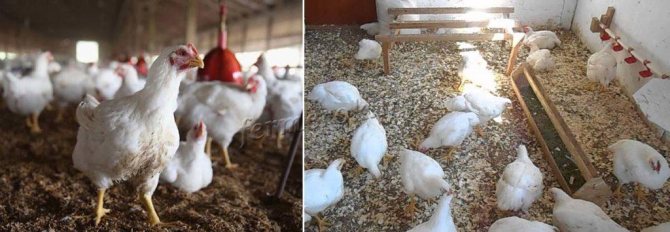

Broiler maintenance Cobb 500
These are unpretentious creatures. Considering that Cobb 500 broilers are raised with the aim of obtaining high-quality meat, they are kept by the floor method in a chicken coop or in cages, without walking. If the bird is bred seasonally, then the chicken coop is made simple, without heating and possibly even without lighting. Such a room should be ventilated, but without drafts.
Important!
When raising chickens in cages, it is worthwhile to take a responsible approach to the preparation of their diet, otherwise, due to a sedentary lifestyle, they may become obese.
A sufficient number of perches are made inside the chicken coop so that all hens and roosters are enough. For layers, you need to equip nests. There is one nest for every 5 individuals. Feeders are placed indoors, like drinkers. If there is a walk, then drinkers should be there.
The room is kept clean. It is cleaned frequently and the litter is changed about once every 3 weeks. It is imperative that the birds are also clean. Any dirt in the cage, on the walk or in the chicken coop is removed so that the birds do not smear the feathers, and for their bathing, a basin with pitch and ash is placed inside.
If you decide to raise broilers at home, you do not need to start by buying chicks. Before purchasing the selected broiler breed, you should prepare a place where they will feel comfortable.
The room must be specially equipped, it provides for ventilation and heating in order to maintain comfortable conditions. At first, the room may be small, some day old chicks are kept in a spacious cardboard box for the first time.


Cobb 500
To equip the poultry house, you will need to purchase:
- heating lamps;
- thermometer (for temperature control);
- Feeders and drinkers;
- Litter that will need to be changed regularly, such as stocking up on sawdust.
Feeding
Nutrition plays no less role than comfort in keeping broilers. It is most important to provide the birds with sufficient nutrients and minerals for the first month so that the birds gain weight quickly.
The very first days of the chickens are fed with dry millet, they gradually begin to introduce eggs, cottage cheese and other products, not forgetting to water the young with vitamins. From 7-10 days, you can begin to introduce compound feed.
On a note. New products should be introduced gradually so that the body has time to get used to the new components.
By the month of the month, broilers' nutrition, in addition to compound feed, cereals, should contain greens and other nutrients. It is important that the food is fresh, not sticky or sticky. Birds must be able to drink water at all times, so the drinkers are filled on time.
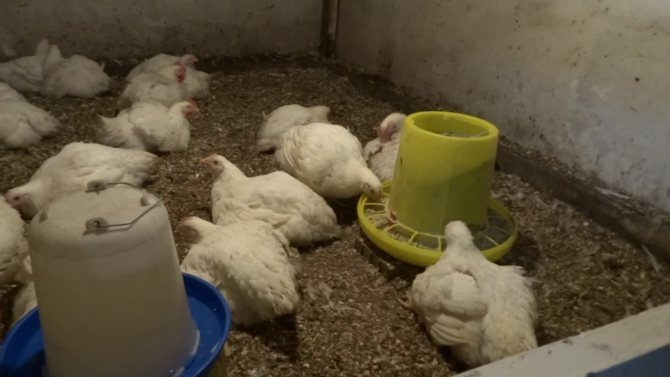

Feeding
Walking
Broilers feel great without walking in spacious areas, so pens for them can be made small. But fresh air is mandatory for them, so it is important to take out or release the birds for at least a couple of hours.
On a note. When walking the crosses, it is recommended to thoroughly ventilate the room and clean it if necessary.
Growing broilers of the Cobb 500 breed has little difference from the general principles of keeping meat breeds of birds. Still, there are certain features of feeding and maintenance, and they should not be ignored.
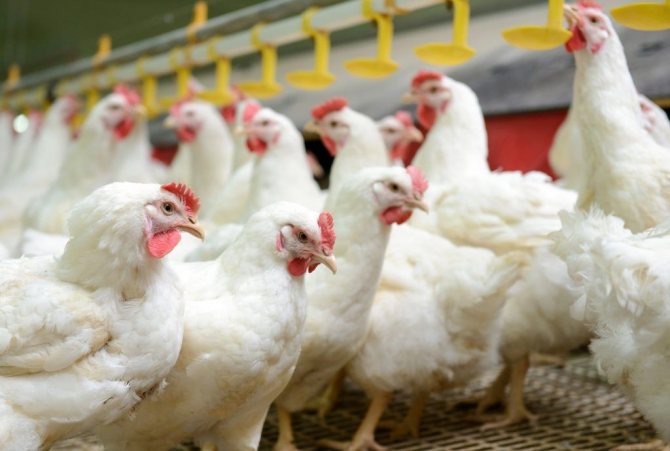

Growing
Today it will not be difficult to buy birds of any breed. It is best to buy young animals of daily age in order to independently choose the scheme of additional supplementation with antibiotics and vitamins, as well as monitor the diet. When purchasing already bred young livestock, you must ask the seller for a certificate, which will confirm the age and belonging to the selected breed.
You can breed chickens of this breed yourself using special equipment. Before laying in the device, the egg is heated to a temperature of 25 degrees. The incubator is set at 37.5-38 degrees. Chicks should hatch in 21 days.
On a note. If you follow all the rules for incubating eggs, then each egg placed in the incubator should be marked with the name of the breed.
While the eggs are in the incubator, you can start preparing the room. At first, it is allowed to keep small chickens in a spacious box, but not for long.When the babies are a little stronger, they are transferred to the poultry house. The Cobb 500 breed does not require long walking, they can always be in a warm room with a constant temperature.
In the first days of life, food bowls are set, but as the birds grow, they are replaced with traditional bird feeders. Up to 10 days, the stocking density of birds should be 50 heads per square, after this period no more than 10 birds should live on one square.
Important! Birds do not tolerate sudden changes in temperature, high humidity and changes in lighting. Therefore, it is important to ensure that the temperature is within 28-32 degrees.
Representatives of Cobb 500 do not tolerate gas pollution and drafts. Until the birds are 2 weeks old, they need at least 25 lux round-the-clock lighting. The use of LED devices is allowed.
It is very important to keep the houses clean. The litter in the barn should be changed every three weeks, it is better if the cleaning is done more often. The bird should not be in mud. In such conditions, it can quickly become infected with diseases, from which birds can fall en masse. Diseases in broilers that are kept in mud develop very quickly.
Possible diseases and their prevention
Cobb 500 broilers are resistant to diseases. Improper maintenance, feeding, care can provoke diseases.
Dyspepsia
Dyspepsia is characterized by symptoms: liquid excrement of a white or yellow hue, with particles of undigested food. Young individuals suffer from dyspepsia. The chicks lose their appetite and become lethargic. High-quality feed, appropriate for the age of the chick, and fresh water will help prevent the disease.
Bronchopneumonia
Symptoms of bronchopneumonia: shortness of breath with an open beak, neck stretching, wheezing. Causes of the disease: hypothermia, sudden changes in temperature. Prevention: before settling in chickens, they clean and disinfect the chicken coop. Living conditions: humidity - 70%, temperature - not less than 14 degrees for adults. It is important to provide a complete diet, which includes vitamins, proteins that enhance immunity.
Marek's disease
Marek's viral disease in chickens is characterized by symptoms: lameness, twisting of the neck, drooping wings, tail, indigestion. Chickens are affected first. Preventive actions: vaccination, compliance with sanitary and hygienic measures, keeping birds by age.
Avitaminosis
Among broilers, vitamin deficiency is most common. This is explained by rapid weight gain. Symptoms: cessation of growth, weight gain, lethargy, impaired coordination of movements, refusal to eat.
Prevention: feed with compound feed according to the table attached to the feed. Self-prepared food is enriched with vitamins, minerals.
Enteritis
With enteritis, the mucous membrane of the gastrointestinal tract becomes inflamed. The immune system is weakened, the level of acidity in the digestive tract changes. Chickens are primarily susceptible to bacterial disease. In the fight and prevention of enteritis, everything is important: balanced food, warmth, light.
Aspergillosis
The fungal disease aspergillosis affects eggs, young animals, and adults. Chick symptoms include lethargy, shortness of breath, stunted growth. Signs of illness in adult birds: diarrhea, exhaustion, cough, shortness of breath, embryo death.
Advantages and disadvantages
Broilers Cobb 500 have a number of advantages, the main ones being: fast growth, high weight, resistance to diseases. A negative characteristic is cold intolerance, which requires additional costs for heating the chicken coop.
Summing up, the following advantages of the Cobb 500 cross can be highlighted.
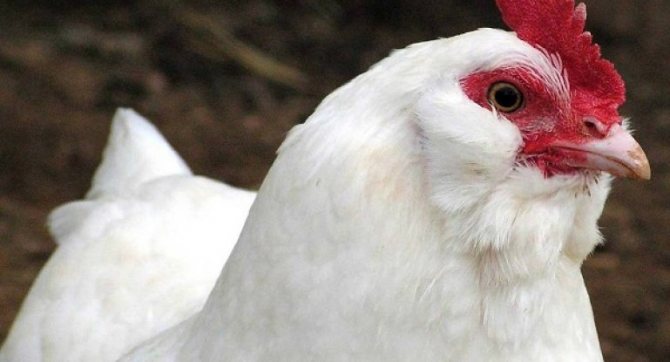

1. Rapid weight gain in an extremely short time, allowing broilers to be slaughtered already at the age of 30 days.
2. Yellow pigmentation of the skin.
3. Low feed costs.
4. High survival factor.
five.Suitable for breeding both in large poultry farms and for small subsidiary farms.
6. Low susceptibility to common chicken diseases.
7. Uniformity of individuals of the same age of both sexes.
The disadvantages of broilers of this type include the lack of the possibility of breeding in the traditional way for birds and intolerance to cold, which significantly increases the energy consumption in the process of growing in some regions in more severe climatic zones.
Breeding at home
To start breeding Cobb 500 broilers at home, you can go in several ways - buy an incubator and eggs or ready-made young stock at the age of 1 day. There are a number of obstacles to traditional hatching breeding paths:
- The first and foremost is the origin. Like most broilers, this breed is a hybrid. Their qualities, obtained by crossing separately selected species, cannot be inherited.
- Another obstacle that prevents them from being removed at home is the lack of maternal instinct in chickens. They cannot hatch eggs, and are not designed to raise offspring.
The high survival rate of young Cobb 500 has a number of advantages when purchasing hatched chicks. This advantageous difference from representatives of similar breeds allows you not to worry when purchasing a ready-made livestock, evaluating their characteristics. The purchase of eggs allows you to save money and start breeding young stock for sale.
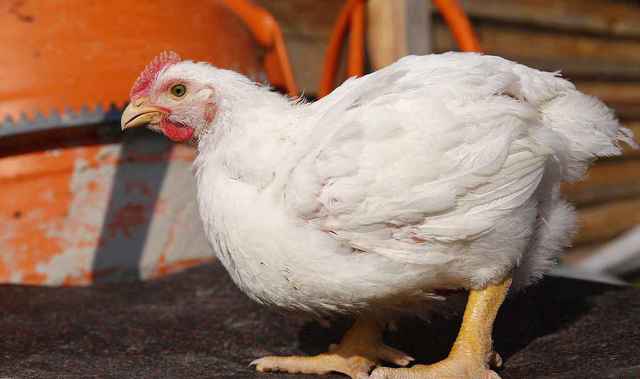

Breeding chickens
Reproduction of Cobb 500 broilers in the traditional way is impossible, therefore, a ready-made hatching egg or live chickens are purchased for breeding. The cost of eggs is quite low and reaches 35-40 rubles per piece, and when buying a large batch, it is about 25 rubles. The price of day-old chickens fluctuates around 100 rubles per head, and when buying a fairly large batch it often drops to 50 rubles.
When breeding by incubation, the chick yield is quite high and, if done correctly, can reach 95%. The survival rate of the young born is almost complete and varies from 97 to 99%. For the incubation method of breeding, it is recommended to purchase models of incubators with an automatic egg-turning function, which allows you to increase the hatching rate of chickens and significantly saves time and labor of the poultry farmer. The capacity of household models is 35-500 eggs, while industrial units can hold several thousand.
The incubation mode for breeding Cobb 500 broilers is not much different from the mode required for breeding chicks of other breeds, and is 37-38 degrees with an air humidity of 65-75%. If the function of auto-turning of eggs is absent, then the first 2 weeks the eggs should be turned 6 to 8 times a day. If this is not done, then there is the likelihood of the embryo drying out to the shell and its death.
For manual overturning, it is recommended to mark already inverted specimens. This will help you avoid missing an inverted egg and will avoid confusion. After 10 days in the incubator, the eggs are cooled to room temperature for 15 minutes twice a day. Broiler chickens are born on day 21.
The hatched chicks are placed in a brooder or heated box and kept at a temperature of 30-32 degrees. After a week, it is gradually lowered by 1-2 degrees per day until it reaches 23-25 degrees. From the moment of birth to 2 weeks of age, the chicks are provided with not too bright round-the-clock lighting, then it is reduced by an hour daily and brought to 18 hours a day.
We recommend reading our other articles
- Kalanchoe flower
- How many grams are in a teaspoon
- Bronze broad-breasted turkey
- Fertilizing cabbage seedlings
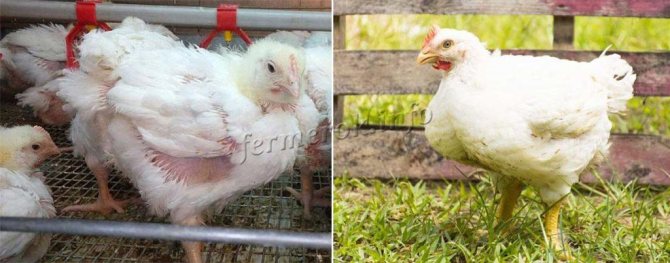

It is difficult to obtain Cobb 500 broilers by natural method.Usually, breeders buy either eggs and grow them themselves in incubators, or young animals. When breeding, you need to provide the chicks with normal care, warmth, lighting, feeding. The features of caring for chicks are the same as in the case of other breeds. If done correctly, the survival rate of young animals will be at least 97%.


Photo incubator and chickens
Important!
One of the main disadvantages of the Cobb 500 is the inability to breed poultry naturally. Eggs only need to be purchased separately.
In the first 2 weeks, 24th lighting is provided. From 14 days you can set a 12-hour day. The temperature should be slightly elevated so that the chicks do not freeze. The brooder should be such that the chicks are not crowded. They must have a place to run, to stretch their legs, wings. The feeder is usually installed in a common, but large, so that everyone has enough food. With a drinking bowl, the meaning is the same - there should be enough water!
In the case of breeding more than 20 birds, it is imperative to get vaccinated in order to reduce the risk of diseases and their spread.
Purebred broilers cannot be bred at home. The characteristics of each subsequent offspring deteriorate, productivity decreases. This is due to the breeding of a hybrid by special crossing.
Incubation
Incubator eggs are purchased from the manufacturer to obtain a purebred breed. The incubator is warmed up to 25 degrees before laying the eggs. The temperature regime is maintained within the range of 37.6-37.8 degrees Celsius. After 21 days, offspring appear. Laying hens of a different breed are also used.
Day-old chicks need a dry, warm, well-lit and ventilated room.
Feeding
A special compound feed is used for young animals. Feeding is carried out 8 times a day. Constant lighting helps you find food. In the following weeks, the number of feedings is reduced. By the age of one month, feeding the young is brought to two meals a day.
Broiler maintenance
Chicks are born with a weight of 40 g. In a week their weight reaches 160 g. In a month they can be used. The live weight of the chick is 1.5 kg. At a month and a half, the weight of an individual with normal development reaches 2.8 kg. Unlike other crosses, Cobb 500 broilers gain weight up to 2.5 months, but they prefer to lead them for slaughter already in 30-40 days. No distinction is made between cockerels and hens. The birds are kept together: they have the same weight gain.
There is a high survival rate of chickens, 97%. Under good conditions, they rarely get sick, but they still carry out preventive measures for them: they drink vitamins and antibiotics. Cobb 500 poultry meat is of high quality. It is juicy, soft, used for instant cooking.
The disadvantage of the cross is that the individuals do not make up the parent herd. Parents are not able to pass on the qualities inherent in them to their offspring. Poultry farmers have to purchase chicks from the producer to renew their stock.
The Cobb 500 bird is kept in cages. It is not suitable for free content. Newborn chicks are housed in brooders. The density of the herd is not more than 12 heads per 1 m 2. Within a week, the chickens are placed in other cages, no more than 5 heads per m 2. Individuals are massive and large in size.
Newborn chicks withstand temperature conditions. For the maintenance of day old chickens, it is recommended to +33 C. From 2 weeks, the temperature begins to decrease. By the 30th day, the cages should not be higher than 20 C. If broilers are cold, then they eat poorly, they stop gaining weight.
The humidity in the house is maintained at 65%. With underestimated values in the bird, the mucous membranes of the upper respiratory tract begin to become inflamed, signs of conjunctivitis are noted. With high humidity, there is a risk of developing colds.In the poultry house, ventilation must be carried out, but drafts should not be allowed. Optimal conditions for keeping livestock are easy to create both in poultry farms and in home chicken coops.
Broiler cages are kept clean. The trays are washed before each feeding. Drinking bowls are cleaned once every knock. The feeders are disinfected after each serving of mash or dry food. Be sure to monitor the freshness of the air.
For broilers to grow well, they need good lighting. Infrared lamps are installed in brooders. They are not only lighting, but also heating devices. The chicks are not turned off for 2 weeks. By the month, the length of the day is reduced to 18 hours.
Before settling the livestock in the poultry house, a total disinfection is carried out. At home, the chicken coop is treated with lime, the cages and trays are washed. After using the herd, a technical break of 21 days is maintained.
The specifics of maintenance and care
Growing Cobb 500 broilers at home is within the power of even novice poultry farmers. Chickens do not require the creation of any special conditions and can be content only with regular and balanced feeding and the presence of a warm chicken coop. Poultry can be kept in both floor and cage ways, the latter being the most preferred for broilers.
Prerequisites for arranging a chicken coop are the presence of ventilation and the absence of drafts. In addition, strict adherence to the temperature regime is required. Broilers love warmth and do not tolerate hypothermia or sudden changes in temperature. Also, the appearance of mustiness, dampness and a large accumulation of dust should not be allowed.
The light regime is also important. Broilers are in great need of good lighting to keep their food going at night. This is especially true for chickens from birth to two weeks of age. For older chickens, an 18-hour daylight hours are enough. The optimal lighting option is red lamps, which create a warm, diffused light that is most favorable for the bird's perception.
An important point in broiler management is keeping the chicken coop clean. So, after slaughtering a batch of chickens, it is imperative to completely clean the room of bedding, droppings and small debris. Then the coop should be disinfected with any disinfectant and ventilated well.
The best option would be to whitewash the walls and ceiling with lime, as well as treat the entire house with sulfur dioxide. For routine processing of the premises in the presence of a bird, you can use agents that are safe for chickens and humans, such as Brovadez-plus or Virotsid. The first can be used both for prophylactic purposes, treating surfaces with a 0.25% solution, and for the destruction of pathogenic flora in infectious diseases. In the latter case, it is recommended to use a 3% solution.
"Virocid" is intended for the elimination of pathogens, viruses and mold. It is often used for cleaning cages and washing feeders and drinkers. To destroy the fungus, you can use "Biodez-R", which is also completely safe for broilers. For preventive treatment, a 1% solution of the substance is taken, while a 4% solution is already used to destroy various infections, including tuberculosis.
At home, growing broilers is in cage, floor keeping. The room must be ventilated and warm. Birds are kept separate from other breeds.
Optimal conditions
Broiler breed Cobb 500 in the process of growing requires the implementation of some rules that contribute to rapid weight gain. Establish the correct temperature, light regime, starting from one day of age. They monitor the cleanliness of the chicken coop.
The amount of planting per 1 m2 is 30-42 kilograms of live weight.
Temperature regime
For chickens, a temperature regime of 27 ° C ... 33 ° C is important. After a week, the heat level is reduced every day by 2 degrees. Lower the temperature to at least 14 degrees.
Light mode
Chicks need 24/7 lighting. After 14 days, daylight hours are reduced by 1-2 hours. Until the 14-hour day is established. Direct sunlight is contraindicated.
Poultry treatment
The new herd is brought into the prepared room. They are freed from debris, disinfected. The walls and floors are covered with lime. In the future, they monitor the cleanliness of the litter. They change it in whole or in part 2 times a week for adults, for young animals every other day.
Breed content
Correct bird keeping will promote development according to norms and will also help prevent many diseases.
Conditions of detention
It is strictly not allowed to keep broilers with the possibility of walking. Optimal outdoor or cage content. With the first option, muscle gain is faster. For 1 sq. m. it is allowed to place about 20 chicks or 10 grown-up individuals.
Temperature regime
The second most important condition for the correct content is the optimal temperature regime. Broilers require a constantly high air temperature, do not tolerate hypothermia, a sharp temperature drop. it is also unacceptable to leave drafts in the house. In this case, the room must be equipped with a ventilation system to prevent mustiness and dustiness.
Ideally, the temperature should be in the range of + 27-33 ° C. At low rates, the chickens will huddle, huddle near the heater. But temperatures above normal will also not be beneficial - the bird's appetite will decrease, it will become apathetic.


Electric heating pads or infrared lamps can be used to heat the house.
Light mode
From birth to 2 weeks of age, house lighting should be available 24 hours a day. The fact is that at this time the bird is actively consuming food, in the absence of light, feeding is impossible, which as a result will negatively affect weight gain. After 14 days, you can gradually reduce the length of daylight hours, bringing it to 18 hours. It is advisable to use red lamps.
Food
Nutrition should be balanced and in sufficient quantity. Be sure to add vitamin and mineral complexes to the diet. It is important to ensure that portions are constantly increased to meet the increasing needs of fast growing birds. To avoid mistakes in the preparation of the diet and save time, you can buy ready-made high-quality compound feed, the composition of which has already been matched to the needs of broiler breeds.
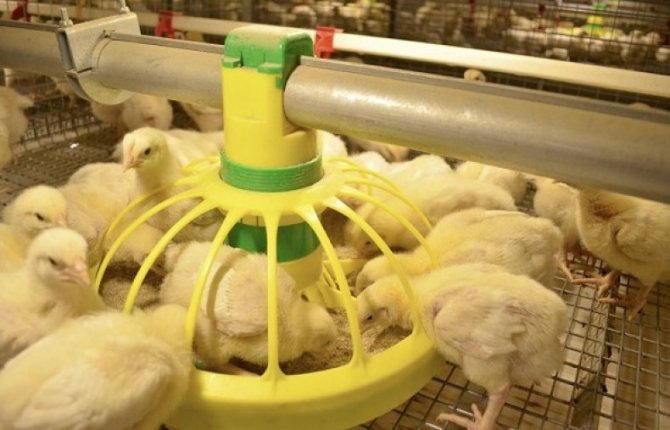

These feeds are divided into several groups for different ages of birds:
- "Prestart". From the first day of life for 5 days. Up to 15 g of feed is required per day per individual.
- "Start". Used at the age of 6-18 days. The daily feed consumption is 25-90 g, depending on age.
- "Fattening". It is applied from 19 to 37 days. The daily consumption increases to 100-130 g.
- "Finish." From 38 days to slaughter. At this stage, the daily feed requirement is 160-170 g.
Table of the ratio of weight and feed consumption of broiler chickens
Below is a table that clearly shows the ratio of weight and feed consumption for broiler chicken.
| Age, days | Live weight, kg | Feed consumption, g / day | Feed consumption from the beginning of fattening, g / head |
| 0 | 0,042 | 0 | 0 |
| 1 | 0,052 | 14 | 14 |
| 2 | 0,066 | 14 | 28 |
| 3 | 0,082 | 15 | 43 |
| 4 | 0,100 | 16 | 59 |
| 5 | 0,120 | 22 | 81 |
| 6 | 0,142 | 25 | 106 |
| 7 | 0,166 | 28 | 134 |
| 8 | 0,193 | 31 | 165 |
| 9 | 0,223 | 35 | 200 |
| 10 | 0,256 | 39 | 239 |
| 11 | 0,293 | 44 | 283 |
| 12 | 0,334 | 49 | 332 |
| 13 | 0,379 | 55 | 387 |
| 14 | 0,427 | 61 | 448 |
| 15 | 0,478 | 68 | 516 |
| 16 | 0,532 | 75 | 591 |
| 17 | 0,589 | 83 | 674 |
| 18 | 0,649 | 91 | 765 |
| 19 | 0,712 | 99 | 864 |
| 20 | 0,778 | 106 | 970 |
| 21 | 0,846 | 112 | 1082 |
| 22 | 0,916 | 118 | 1200 |
| 23 | 0,988 | 123 | 1323 |
| 24 | 1,062 | 128 | 1451 |
| 25 | 1,137 | 133 | 1584 |
| 26 | 1,213 | 137 | 1721 |
| 27 | 1,290 | 141 | 1862 |
| 28 | 1,368 | 145 | 2007 |
| 29 | 1,447 | 149 | 2156 |
| 30 | 1,527 | 153 | 2309 |
| 31 | 1,608 | 157 | 2466 |
| 32 | 1,690 | 160 | 2626 |
| 33 | 1,773 | 163 | 2789 |
| 34 | 1,857 | 166 | 2955 |
| 35 | 1,942 | 169 | 3124 |
| 36 | 2,027 | 172 | 3296 |
| 37 | 2,112 | 175 | 3471 |
| 38 | 2,196 | 177 | 3648 |
| 39 | 2,279 | 179 | 3827 |
| 40 | 2,361 | 181 | 4008 |
| 41 | 2,442 | 182 | 4190 |
| 42 | 2,522 | 183 | 4373 |
| 43 | 2,601 | 184 | 4557 |
| 44 | 2,679 | 185 | 4742 |
| 45 | 2,756 | 186 | 4928 |
| 46 | 2,833 | 187 | 5115 |
| 47 | 2,909 | 188 | 5303 |
| 48 | 2,984 | 188 | 5491 |
| 49 | 3,058 | 188 | 5679 |
Cobb 500 broilers can be an excellent option for both small farms and industrial poultry because these birds do not need long-term feeding to gain optimal weight, which is very effective in terms of cost-benefit ratio.
Even in a small area during the summer season, 2-3 generations of Cobb 500 can be grown, the meat of which has excellent taste and an attractive presentation.
| The age of the young by day | Weight (g) | Daily gain (g) | Daily feed intake (g) | Total feed weight (g) |
| 0 | 41 | |||
| 10 | 260 | 26 | 39 | 245 |
| 20 | 775 | 39 | 100 | 956 |
| 30 | 1572 | 52 | 168 | 2350 |
| 40 | 2456 | 61 | 198 | 4220 |
| 50 | 3246 | 65 | 203 | 6246 |
| 56 | 3644 | 65 | 198 | 7451 |
Incubation of eggs
Thanks to the incubation system, it is possible to obtain daily Cobb 500 chicks in any season. For such purposes, you will need to purchase a high-quality system.
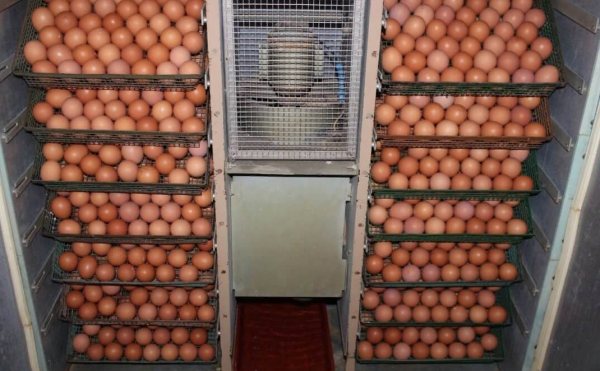

Industrial incubator
The eggs should not be too small or large because they are rarely viable. It is worth carefully examining the shell to exclude cracks, traces of droppings on the surface.
Eggs are laid with sharp ends down or horizontally, depending on the type of incubation system. Before laying them, they should be warmed up at room temperature.
Table 2. Preparing eggs for incubation: step by step instructions
| Illustration | Description |
| The surface of each egg must be carefully examined. | |
| Slight contamination must be removed with warm water and a cotton pad. A new cotton pad should be taken for each egg. | |
| The incubator must be preheated to a temperature of 38 degrees, and then the eggs must be placed there. |
The incubation period is 21 days. The optimum temperature for heating eggs is 37.7-38 degrees. If this rate is exceeded, the embryo dies. Periodically, the eggs are scanned with an ovoscope, in the absence of embryo development, they are removed.
Features of bird feeding


Compound feed, cereals, root crops and vegetables
Cobb 500 broilers eat simple food, no frills, so you will not need to spend money on expensive feed. Chickens gain weight quickly, but this should be as balanced as possible.
For broilers, of course, compound feed is best suited. In this case, you can buy a not very expensive brand, the birds will be happy with that. In addition, you will need cereals, root vegetables, boiled or fresh vegetables, finely chopped. Soaked bread, crackers will not hurt, but such an additive is no more than 5% of the daily requirement. And, of course, fresh grass and insects should be part of the feeding.
Premixes are added to the mash, if possible, in order to increase their nutritional value and enrich the diet with vitamins. The amount and type of premix should be checked with your veterinarian.
Important!
Broilers have a fast metabolism. Therefore, in order for the bird to quickly gain weight, access to feed must be constant!
Water should be in the drinker all the time, because if it is not there, this can affect its productivity. Therefore, they usually put nipple drinkers or those that are connected to the water supply. You can just put large drinking bowls so that the water is regular, but the main thing is safe, so that the birds do not drown in them and so that they do not turn over, arranging a flood in the poultry house.
The weight gain of Cobb 500 broilers is directly dependent on the diet and nutritional balance. Experienced breeders prefer not to calculate the required amount of certain nutrients, but use ready-made, clearly balanced feed, consisting of fiber and grain mixture. With its use, after a month and a half, it is possible to get a full-fledged chicken, ready for slaughter.
Professional poultry farmers for every age recommend using their own compound feed. So, newborn chickens up to 10 days of age should be fed with the crushed composition "Start", which is designed for the delicate stomachs of babies, contains a huge amount of protein and is well digested. Then, until the 23rd day, the young are given "Growth", which contains a large percentage of proteins necessary for the development of muscle mass and good weight gain.
Moreover, the feed contains a sufficient amount of calcium, which is necessary for the correct formation of the skeleton. And starting from the 23rd day until slaughter, the bird is fed with Finish compound feed. The composition is quite high in calories and includes a lot of starch, fiber and fat, while the amount of protein is somewhat reduced and meets the recommended standards.
- 48% chopped corn or cornmeal;
- 13% wheat;
- 7% meat and bone meal;
- 1% vegetable fat;
- 18% sunflower meal;
- 8% barley;
- 3% herbal flour;
- 5% feed yeast;
- 0.1% salt.
When using such a mixture, it should be borne in mind that the high content of wheat slightly impairs the absorption of phosphorus and calcium. Therefore, if there is no opportunity to replace it with barley, the amount of supplements with phosphorus and calcium is slightly increased. It is also recommended to add protein-vitamin complexes to the prepared mash in a volume of at least 10% of the total amount of the mixture.
In order to reduce the cost of keeping broilers as much as possible and reduce the consumption of compound feed, kitchen waste and vegetables from the garden are included in the diet of birds. Some farmers have had the successful experience of feeding chickens with boiled potato-based feed with vegetable peelings, grass meal and crushed grains.
As feed for broilers, use specialized feed or prepare it yourself.
In the first 10 days, the chickens benefit from the small fraction starter feed. In the next 11-22 days, there is a rapid set of muscle mass, granular feed is required, for example Growth. At the age of 1 month and further they are fed with finishing compound feed.
Self-prepared food should contain proteins, vitamins, minerals, trace elements. The broilers' diet includes vegetable grain mash, oil cake, meat broth, meat and bone meal.
Additives and water
In the house, clean water should be readily available. They change it every day. In addition to the main food, the diet includes crushed shells, chalk, coarse sand, feed yeast, salt, grass flour.
What birds look like
Creating a new cross, the scientists set themselves the main goal to breed early maturing birds, from which you can get high quality meat products and at the same time minimize the cost of feed.
The ancestors of the Cobb 500 were Cornish with Plymouthrocks. The cross is unstable and not used for further breeding. To get a good livestock, it is necessary to use the Kuchin Jubilee, New Hampshire, Rhode Islands and several other breeds in a timely manner for crossing with the parent flock.
In representatives of the cross, the body is rather massive, with large strong hips. A distinctive feature is the presence of yellow skin, due to which the carcasses have an attractive presentation for the consumer. The color is white, there are no blotches. The color of the comb, face and lobes is red.
Read also: What is the difference between quail eggs and chicken eggs
Broiler Cobb 500 or ROSS 308, which is better?
Cobb 500s have low disease susceptibility and good survival rates, but they can also be susceptible to various diseases that commonly affect chickens. Here are some of the most common diseases that broilers may be exposed to.
1. Dyspepsia. Most often, the disease is caused by expired or unsuitable for age food, which the chicks are not able to digest due to the insufficiently developed digestive system and the lack of necessary enzymes. The disease affects chickens in the first time after birth. With dyspepsia, severe poisoning of the body is observed, which manifests itself in the form of liquid excrement of white or yellow color with undigested food particles against a background of weakness and lack of appetite.
2. Bronchopneumonia. May occur against the background of hypothermia. It can be determined by the severity of breathing with an open beak, wheezing when breathing, stretching the neck. Treatment should be prescribed by a veterinarian, otherwise the death of a sick bird is possible.
3. Marek's disease. The incidence of it in broilers can reach 85%. Symptoms include lameness, drooping of the wings and tail, twisting of the neck, and sometimes full or partial visual impairment. An accurate diagnosis can only be made by a veterinarian.
4. Avitaminosis.Due to their rapid growth, vitamin deficiencies in broilers can be much more acute than in non-beef chickens. To prevent vitamin deficiency, the poultry ration should be additionally enriched with vitamins when feeding poultry with non-specialized feed, where the composition already contains the required amount of necessary substances.
5. Enteritis. Inflammation of the gastrointestinal tract. Young chickens are susceptible, treatment is carried out with drugs of an antibacterial spectrum of action.
6. Aspergillosis. Fungus disease affects the respiratory tract. As a rule, aspergillosis occurs when the conditions of detention are violated, which contributes to the reproduction of the fungus.
7. Salmonellosis. A disease that is dangerous not only for chickens, but also for humans. In case of infection with salmonellosis, sick individuals are subject to slaughter without being used for food.
The most effective way to prevent the disastrous consequences of bird morbidity is to comply with keeping standards. Before settling in a new batch of chickens, a general cleaning with disinfection and change of bedding should be carried out in the room, feeders and drinkers should be washed properly. House ventilation is required to provide fresh air. Feed and water should always be kept fresh to avoid the growth of pathogenic bacteria.


Photo Cobb 500 and ROSS 308
Broilers Cobb 500 and ROSS 308 are considered one of the most popular, widespread and affordable. But which view is better? Cobb 500 is a productive breed, birds grow quickly, do not eat much, weigh a lot. In addition, hens can produce eggs, albeit in small numbers. The survival rate is 94-98%.
If we consider the ROSS 308, then you will notice that this is a more versatile bird. It is purchased both for meat and eggs, since their egg production is higher than that of the Cobb 500. But there is one caveat. The bird does not give much meat, and it is more demanding in feeding, otherwise it stops rushing.
Summing up, I must say that the Cobb 500 is a more profitable option. This is the most efficient broiler in the world at the moment. But if the farmer needs a universal option, and not purely meat poultry, then the ROSS 308 will still be the best choice.
Diseases and Control Measures
Despite the relatively strong health, as for broiler breeds, the COBB 500 variety can be subject to some ailments. The main causes of diseases are deviations from the standards of maintenance and care, unsanitary conditions, poor quality of feed and violation of feeding rules. It is necessary to assess the condition of the bird on a daily basis to calculate the weakened, fallen, sluggish cough. Possible diseases of the breed:
- Dyspepsia or indigestion. Newborn chickens are very susceptible to this condition.


Due to a weak and incompletely formed digestive system, as well as the lack of some enzymes, they are unable to digest certain foods. To prevent the disease, you need to carefully prepare the room before the day-old chicks arrive, choose high-quality feed, monitor the size of granules for newborns, and introduce fermented milk products into the diet. - Avitaminosis. It occurs as a result of a lack of nutrients in the feed. For warning, you need to monitor the portions of food; when feeding with mash, it is imperative to introduce vitamin-mineral complexes.
- Marek's disease. A very dangerous infectious disease that affects the nervous system. It is not treated, therefore, when diagnosed, the bird is sent to slaughter and burned to prevent the spread of infection. Adult broilers are susceptible to diseases.
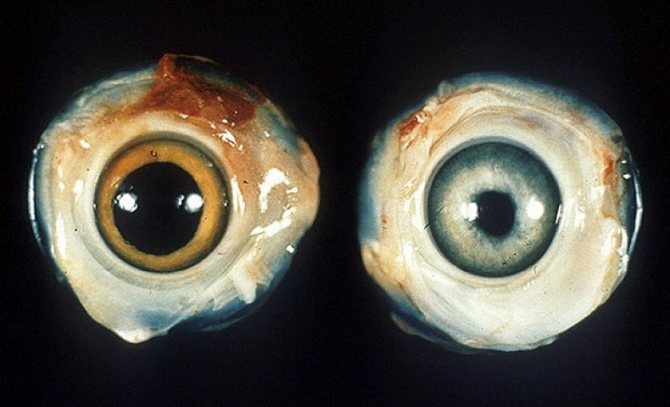

On the left is a normal chicken eye. On the right - the eye of a chicken sick with Marek's disease. To prevent it, day-old chicks are vaccinated, the hatching eggs are thoroughly treated with formaldehyde, before placing a new batch of broilers, the poultry house must be treated with disinfectants. - Salmonellosis. A very dangerous disease, since when infected, the entire livestock is subject to slaughter without the possibility of using the carcasses for food. Preventive measures are the only effective ones: control of food and water quality, purchase of hatching eggs and chickens only in proven poultry houses, and maintenance of sanitary conditions. You can also use the vaccine, but this is only advisable for farms in which cases of salmonellosis are frequent.
- Aspergillosis. Severe infectious respiratory fungal disease. For treatment, iodine preparations are used. Since contaminated feed becomes the cause of the disease, you need to carefully monitor the quality of the purchased products, follow the storage rules.
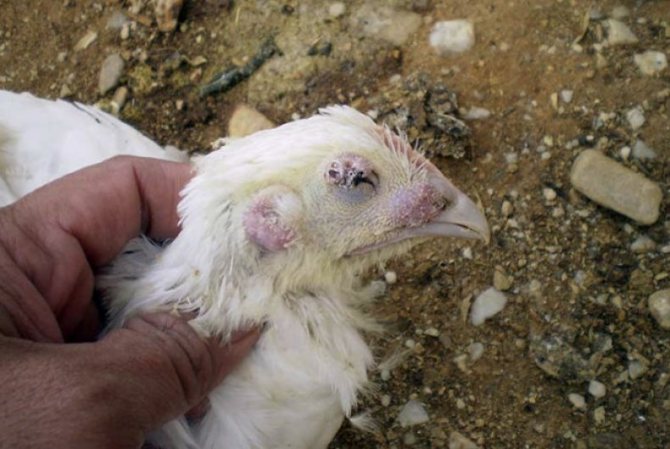

- Pollurose. A bacterial infection that affects birds of any age. In young animals, it proceeds in an acute form. Infection usually occurs through contaminated feed. To combat, antibiotic therapy is used (preparations of nitrofurans, cephalosporins, sulfonamides). When contacting a sick bird, it is important to take into account that this disease is dangerous to humans.
- Bronchitis. Highly contagious airborne viral disease. It can manifest itself as respiratory, nephrosonephritic syndromes, as well as damage to the reproductive organs. It is very important to distinguish bronchitis from other avian diseases, as the clinical picture is blurred. When infested, the house is treated with disinfectant aerosols.
Broilers of the COBB 500 breed have better health than their fellow tribesmen, therefore, cases of infection are quite rare if all conditions of keeping are observed. The popularity of this breed is quite understandable - COBB 500 is profitable to grow at any scale. The demand for meat of this breed is very high, and together with the high taste characteristics and unpretentiousness of the nest, growing these broilers becomes almost a win-win option.
How to raise young
Mostly broilers are raised for meat production, and therefore it makes no sense for them to prepare premises with walking areas. It is optimal to keep the birds by the outdoor method without letting them out into the street or in cages. This method does not allow the birds to move a lot, and this increases the rate of weight gain.
Cobb 500
The young are phlegmatic, do not show aggression, but if the content is incorrect, then some chickens may develop cannibalism. The reason is often hidden in very bright light or an unbalanced diet. In this case, some chicks begin to peck at each other, which often results in death.
Cross-country broilers are suitable for keeping on a private farm. After the young are brought to their permanent place, they must be provided with sufficient heat and light. This applies to chickens at the age of a day. For chicks to gain weight well, they must eat a lot, but they will not eat in the dark. For this, the light is left to burn for a full day for two weeks.
Then the lighting is reduced, but it must be at least 18 hours. The temperature indicator should be at least 27, but not more than 32 degrees. The house should be equipped with a good ventilation system that will provide fresh air, but not create a draft. From him, young animals can get sick and die.
Cobb chickens 500
The owner needs to keep the house clean. Before transferring the young to a new place, a general cleaning is carried out in the room with the use of disinfectants. It is necessary to whitewash the ceiling with walls, a complete change of the litter is made. Drinking bowls with feeders are washed and then doused with boiling water.
The subtleties of growing young animals
Since broilers are raised for meat production, it is not recommended to keep them in large chicken coops with a spacious aviary. So, the possibility of their movement is reduced, which means that body weight is gained faster.
Birds should not build high perches.Due to their body weight, they may not hold and fall, which will entail various injuries.
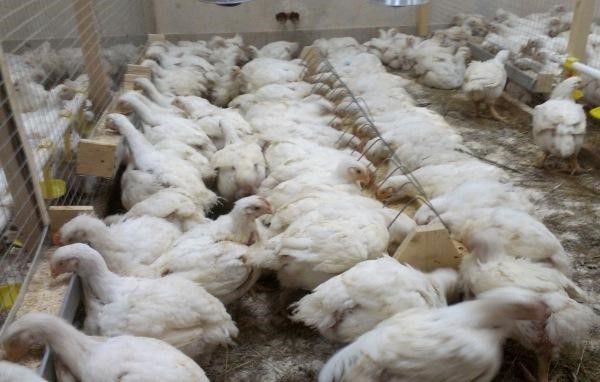

Cobb Teens 500
There are the following options for keeping chickens:
- floor;
- cellular.
When kept in cages, birds gain weight much faster. Floor keeping is usually important when there are a large number of broilers. Sometimes, to save territory, the cages are installed in several tiers. However, you will have to provide lighting for the upper and lower rows.

